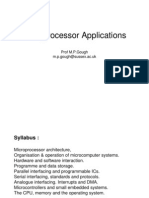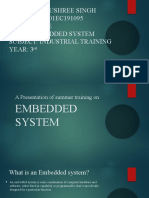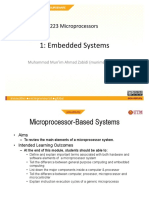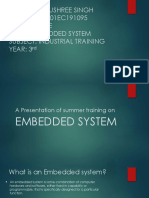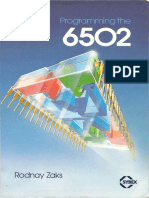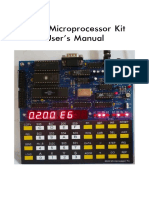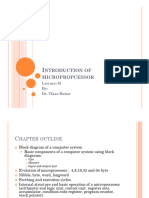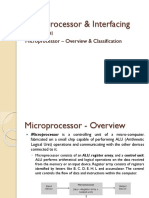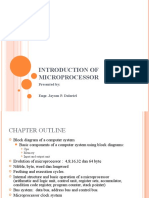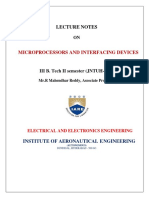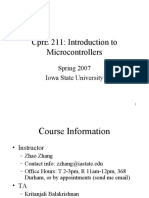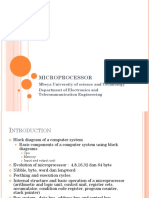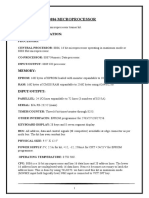0 ratings0% found this document useful (0 votes)
127 views98 pagesThe Simulation of 6502 Microprocessor
The Simulation of 6502 Microprocessor
Uploaded by
silvaenrCopyright
© © All Rights Reserved
We take content rights seriously. If you suspect this is your content, claim it here.
Available Formats
Download as PDF or read online on Scribd
0 ratings0% found this document useful (0 votes)
127 views98 pagesThe Simulation of 6502 Microprocessor
The Simulation of 6502 Microprocessor
Uploaded by
silvaenrCopyright
© © All Rights Reserved
We take content rights seriously. If you suspect this is your content, claim it here.
Available Formats
Download as PDF or read online on Scribd
You are on page 1/ 98
THE SIMULATION OF 6502 MICROPROCESSOR
By:
Alireza Kobari
B.S. in Physics, Pars College;
Tehran, Iran, 1978
Submitted to the Graduate Feculty
in partial fulfillment of
the requirement for the degree of
Master of Science
in
Electrical Engineering
Florida Institute of Technology
1981
The author grents permission to reproduce single copies
: ban
Alireza Kobari
Electrical Engineering Department ak
ie
Title: The Simulation of 65%2 Microprocessor
Major Advisor: Mr, D. Gluntz
ASM65 and KO65 are software programs written in BASIC-
PLUS language end run on a PDP=11/34 computer. The ASM65 is
an assembler and K065 is a simulator,
ASM65 allows the user to create the 6542 assembly
language source program, The system is equipped with helpful _
error messages,
KO65 simulator will execute the 6502 operation code
which is generated by the assembler. The simulator also
allows the user to easily debug his program through features
such as: tracing, single-stepping, and breakpoint.
77692
FLORIDA INSTITUTE OF TECHNOLOGY LIBRARY
ACKNOWLEDGEMENT
The author would like to take this opportunity to
express his sincere appreciation to his major advisor,
Douglas Gluntz, for his support, guidance, and helpful sug-
gestions during the preparation of this thesis.
He would also like to express his, sincere appreciation
to the other members of the oral examination committee, Dr.
John Hadjilogiou, and Dr. J, Choi for their comments and sug-
gestions.
In addition, the author is indebted to Ms. Michel
Serrano and Mr, Augustine Walter for their constructive
suggestions and cooperation.
Finally, a special note of thanks to Mrs. Carolyn
Gatzulis for the neat typing of this manuscript.
A. Kobari
Florida Institute of Technology
August, 1981
TABLE OF CONTENTS
PAGE NO.
CHAPTER TI. INTRODUCTION ......ecceccecscceeces 1
II. 6582 MICROPROCESSOR AND PERIPHERAL
DEVICE (6520) secsecceccsecessesers
III. SIMULATOR SYSTEM (KO65) ........0e 24
IV. USER'S GUIDE FOR ASM65-K065
SYSTEMS se... - 33
vw CONCLUSIONS . Seeeeenees 55
APPENDIX A, 6502 ASSEMBLER CONVENTION ......... 56
APPENDIX B. ERROR MESSAGES 1. essecesessessssoee 63
APPENDIX ©, K065 and ASM65 PROGRAM LISTING .... 68
REFERENCES erereesy teeee 94
CHAPTER I
INTRODUCTION
4.4 BACKGROUND
an assembly lengusge allows the user to be directly
related to the hardware of a given computer, In addition to
allowing the user to exploit the structure of the computer
in developing efficient software, essembly languages also
serve as an educational tool for a beginner to get acqueint-
ed with the herdware of a given computer system.
The suthor's experience with smell machines had
indicated that running assembly language progrems on mini
and microcomputers without well defined support software
libraries, requires considerable insight into the hardware
of the computer system being used. Lack of support software
can prove extremely frustrating to the beginner who wishes
to use assembly language in a small computer system.”
The development and debugging of software for new
processor-based systems is frequently done with the aid of a
simulator, which is s program ‘running on a host computer
having the property of simulating the instruction set and
the programming model of the new or target processor. after
the software is initially debugged using the simulator,
further debugging of the software system is done with the
aid of debug programs and various software facilities that
provide breakpoint, single-stepping, and other capsbilities.
A simlator of a microcomputer system that runs on a
large machine has basic advantages. The large system should
have extensive software support, In ill-configured micro-
computer systems, hardware problems could cause programming
errors. However, in the case of a simulator, if a user's
program does not work, it is due to a programming error and
not the fault of the host computer. Further, a good simula-
tor possesses debug features that even the real microcom-
puter system does not support.
With the introduction of microprocessor development
systems, a new tool has been made availeble to the designer
in the form of the microprocessor simulator. Today's
simulators combine many powerful software development tools
into one convenient, easy-to-use system and greatly facili-
tates the process of integrating the hardware end software
components of newly developed microprocessor-based systems.
The advantages of using a simulator include the
ability to load the newly developed programs into the
simulation memory and execute these programs in the develop-
ment eycle. It also includes the ability to debug software
under controlled conditions as it can run, halt, end single-
step the processor as well es examine the register and
memory contents.
4.2 OBJECTIVE
The objective of this thesis is to simulate the 6502
microprocessor using the BASIG-PLUS language software of the
PDP-11/34, It will help users run 6582 assembly language by
first creating the assembly source program in EDIT mode.
The assembler, ASM65', will convert the assembly program to
machine language and the simulator, K065, will execute the
program, This feature will allow users to debug and study
their programa.
The ASM65 and KO65 software programs are written in
BASIC-PLUS language and are compatible, with some modifice-
tion, to any computer which has a BASIC interpreter and
enough memory space. The interactive time sharing system
RSTS/E operating system on PDP-11 model 34 was used for this
design.
The author used the EDIT software progran that
already exists in the PDP-11 minicomputer as a matter of
convenience and to increase the capability of debugging the
source program. Thus, the user can easily create his pro-
gram and in case of any error during assembly time he can
correct the program, using EDIT mode. ASM65 is an assembler
that has been modified due to the different BASIC Interpret-
er of the PDP-11/34, The error messages have also been
designed to inform the user of all syntax errors at the end
of assembly time. The user will then go back to the ZDIT
mode for error correction. The last part of this system is
1 copyright Sybex, Inc. Referenced with kind permission
4
the KO65, which is » simulator. The simulator is a program
which can accept different commands, such as: displey
register and memory contents, single-step the program, etc.,
in order to execute the 6592 microprocessor instruction set.
CHAPTER IT
6502 MICROPROCESSOR AND PERIPHERAL DEVICE (6520)
2.1 INTRODUCTION
The past several yeers have seen the development of
an exciting new concept in electrical design. The micro-
computer started out as a relatively simple, difficult-to-
use, programmable device capable of hendling simple control
or computations) problems. However, it has since matured
into 2 powerful, inexpensive, easy-to-use device capable of
controlling all but the most complex of systems.
Conventional system design is rapidly being revolu-
tionized by the component that forms the heart of the micro-
computer---the large scale, single-chip, programmable
microprocessor (CPU),
The success of the microprocessor is based on the
fact that it permits the design engineer and programmer to
apply their expertise in solving a multitude of design
problems, A small number of lerge integrated circuits can
be configured to solve design problems from the simplest to
the most complex.
2.2 SIGNAL LINES
Figure 2-1 summarizes the pinouts of the 6582 cPU.
These pins and their uses in microcomputer systems are
discussed separately below.
2.2.1 ADDRESS BUS (AB@S-AB15)
The Address Bus buffers on the 6582 microprocessor
sre push/pull type drivers cepable of driving at least 130
PF and one standard TTL load.
vss ——ie
Roy ——» ——> 6, our
@, our + +~—s0.
— ~— 9,1
Ne. No.
i ——> Ne.
sync +——— ——> aw
vee . 3 ‘e0
Bo . 2 a1
Bt ° ” 082
sz " om x» psa
83 ” 2h (~~ oes
Aga 7 = pes
ABs “ z 086
a8 1s = 087
ae7 " s ‘A818
age ” » Aas
ase ” 2d (ass
Ago ® 2 agi
asi 2 x vss
N.C. = Ne connection
Figure 2-1 6502 Pinout Designation
The addressing technique involves putting an address
on the Address Bus which is known to be either in program
sequence, on the same page in program memory, or st a known
point in RAM.
The address is valid 300 ns (at 1 MEZ clock rate)
into the #1 clock pulse and remains stable until the next
1 pulse.
2.2.2. DATA BUS (DB-DB7)
All instruction and data transfers between the pro-
cessor and memory take place over the bidirectional data
lines. The buffers driving the data bus lines heve full
"three-state" capability.
Each data bus pin is connected to an input and an
output buffer, with the output buffer remaining in the
"floating" condition except when the processor is trans-
ferring date into or out of one of the support chips.
2.2.3 READ/WRITE (R/W)
The read/write line allows the processor to control
the direction of data transfer between the processor and the
support chips e.g, memory (ROM, RAM), I/O interface, etc.
This line is high except when the processor is writing to
menory or to a peripheral interface device.
2.2.4 READY (RDY)
The RDY input delays execution of any cycle during
which the RDY line is pulled low. .
The primary purpose of the RDY line is to delay
execution of a program fetch eyele until data are available
from memory.
The RDY function will not stop the processor in a
cycle in which a WRITE operation is being performed.
2.2.5 NON-MASKABLE INTERRUPT (WMT)
The MAT input, when in the interrupted state, always
interrupts the processor after it completes the instruction
currently being executed, This interrupt is not “markable
©-8+, there is no way for the processor to prevent recogni-
tion of the interrupt,
The NMI input responds to a negative transition,
The NMI signal must ve low for at least two clock cycles for
the interrupt to be recognized, whereupon, new program count
vectors are fetched,
2.2,6 INTERRUPT REQUEST (IRQ)
The interrupt request (IRQ) responds in much the
same manner as NMI. However, this function can be enabled
or disabled by the interrupt inhibit bit in the processor
status register, As long as the I flag (interrupt inhibit
flag) is a logic 1, the signal on the TRO pin will not
affect the processor.
The TRG pin is not edge-sensitive. Instead, the
Processor will be interrupted as long as the I flag is a
logic "0" and the signal on the IRQ input is at GND.
Because of this, the TRO signal mist be held low until it
is recognized. To assure that the processor will not rec-
ognize: the interrupt more than once, the I fleg is set
automatically during the last machine cycle before the
processor begins executing the interrupt software, begin-
ning with the fetch of progrem count.
2.2.7 RESET (RES)
The RES line is used to initialize the microprocessor
from a power-down condition. It may also be used to reset
the system after power-up time. During the power-up time
this line is held low internally, and writing from the micro~
processor is inhibited. When the line goes high, the micro-
processor will delay 6 cycles and then fetch the new program
count vector from specific location in memory. This is the
start of the user's code,
2.2.8 SYNCHRONIZATION SIGNAL (SYNC)
In the 6592, a SYNC signal is provided to identify
those cycles in which the processor is doing an Opcode
fetch, The SYNC line goes high during phase 1 clock pulse
of an Opeode fetch end stays high for the remainder of that
cycle.
2.2.9 SET OVERFLOW (S.0.)
This pin sets the overflow flag on a negative tran-
sition from TL one to TTL zero, This is designed to work
with a future 1/0 part and should not be used in nommal
applications.
2.2.10 POWER LINES (Vec, Vss)
The Vee and Vss pins are the only power supply con-
nections to the chiv, The supply voltage is + 5.0V DC + 5%,
2.3 FUNCTIONAL FEATURES OF THE 6502 MICROPROCESSOR
10
A block diagram of the basic architecture is shown
in Figure 2-2. This section begins with an enalysis of this
dlock diagram, discussing the function of the various regis-
ters, data paths, etc, A detailed discussion of the opera-
tion of the various pins on the chip has been described.
The internal organizetion of the processor can be
split into two sections, In general, the instructions
obtained from program memory ere executed by implementing
a series of data transfers in one section of the chip
(register section). The control lines which actually cause
the data transfers to teke Place are generated in the other
section (control section), Instructions enter the processor
on the data bus, are latched into the instruction register,
and are then decoded along with timing signels to generate
the register control signals.
The timing control unit keeps track of the apecific
cycle being executed. This unit is set to "T" for each
instruction fetch cycle and is advanced st each phase one
clock pulse. Hach instruction starts in "?9" and goes to 71,
2,13, ete, for as many cycles as are required to complete
execution of the instruction. Esch data transfer, etc.,
which takes place in the register section is caused vy
decoding the contents of both the instruction register and
the timing counter,
Additional control lines which affect the execution
of the instructions are derived from the Interrupt logic and
from the Processor Status register. ‘The Interrupt logic
4
——-nrastin sterion comin section
ema a
Weae
mb
wmermucien
Loe}
euitSaion [S885
‘ea
Soren eaten
irene
Figure 2-2 6592 Internal architecture
controls the processor interface to the interrupt imputs to
assure proper timing, enabling, sequencing, etc. which the
processor recognizes and services.
42
The Processor Status register contains a set of
latches which serve to control certain aspects of the pro-
cessor arithmetic and logic operations, and to indicate the
status of data either generated by the processor or trans-
ferred into the processor from outside.
Since the real work of the processor is carried on
in the register section of the chip, a detailed study will
be made of this section. It comprises the following com-
ponents:
* Data Bus Buffers
* Input Data Latch (DL)
* Program Counter (PCL,PCH)
* Accumulator (A)
* Apithmetic Logic Unit (ALU)
* stack Pointer (Ss)
* Index Registers (X,Y)
* Address Bus. Latches (ABL, ABH)
* Processor Status Register (P)
Figure 2-3 summarizes the Processor Programming
Model for the 6542.
a acer
TTF otrmeasren +
2 ' mdaeadead | | CU imooisase ve orsaace
CSF met Co on
COEF secre Preston shoe
Figure 2-3 Programming Model 6502
13
At 1 MHZ, the data which goes into the processor
from the progrem memory, the data memory, or from peripheral
Gevices, appear on the data bus during the last 100 ns of
phase 2 clock pulse. No attempt is made to actually operate
on the data during this short period, Instead, it is simply
transferred into the input data latch for use during the next
eycle. The data latch serves to trap the data on the data
bus during each phase 2 clock pulse, The data can then be
transferred onto one of the internal busses, and from there
into one of the internal registers. If an arithmetic or
logic operation is to be performed, using the data from
memory and the contents of the accumulator, data at the
inpat data latch will be transferred onto the internal data
bus as previously described. From there it will be trans-
ferred into the ALU. At the same time, the contents of the
accumlator will be transferred onto a bus in the register
section and from there into the second input to the ALU.
The results of the arithmetic or logic operation will be
transferred beck to the accumulator on the next machine
cycle by trensferring first onto the bus and then into the
accumulator, All of these data transfers teke place during
the phase 1 clock pulse,
The program counter (PCL,PCH) provides the addresses
Which step the processor through sequential instructions in
the program. Each time the processor fetches an instruction
from program memory, the contents of PCL are placed on’ the
low-order 8 bits of the address bus and the contents of PCH
14
are placed on the high-order 8 bits. This counter is incre-
mented each time an instruction or data is fetched from
program memory.
The Accumlator is a general-purpose 8 bit register
which stores the results of most arithmetic and logic opera-
tions. In addition, the Accumulator usually contains one of
the two data words used in these operations.
‘Siac Poin
sx
sta
Src
sty
ed Tay, ae
Pu
tau
niv| [efolifzle
Figure 2-4 6502 Data Path :
All logic and arithmetic operations take place in
the ALU; this includes incrementing and decrementing of
internal registers (except PCL and PCH). However, the ALU
cannot store data for more than one machine cycle; if data
are placed on the inputs to the ALU at the beginning of one
cycle, the result is always gated into one of the storage
registers or to external memory during the next machine
cycle. Each bit of the ALU has two inputs. These inputs
15
can be tied to various internal busses or to a logic zeros
the ALU then generates the SUM, AND, OR, BTC. function using
the data on the two inputs.
The Stack Pointer (S) and two Index Registers (X and
¥) each consist of 8 simple latches. These registers store
data which are to be used in calculating addresses in date
memory, The date path of the 6592 is given in Figure 2-4,
The Address Bus Buffers (ABL,ABH) consist of a set
of latches end also TTL compatible drivers. These latches
store the addresses which are used in accessing the periph-
eral devices (ROM,RAM, and I/O).
2.4 DEVICE TIMING (TIME-BASE GENERATION)
The 6592 can be used with en externally generated
time base consisting of either a TTL-level single-phase
clock, crystal oscillator, or RC network.
Figures 2.5, 6 end 7 show the configuration for set--.
ting the frequency of oscillation with a crystal or with an
RC network,
7404
2” SYSTEM @,
Pin
37 Qin
6502 Di cove 39 Op out
Figure 2-5 6592 Parallel Mode Crystal Controlled Oscillator
7408
SYSTEM 9,
2 ow
6502
v
Figure 2~6 6592 Series Mode Crystal Controlled
Oscillator
SYSTEM 0,
in
out
Figure 2-7 6582 Time Base Generator-RC Network
2.5 INSTRUCTION SET
Table 2-1 is a summery of the 6562 Instruction Set
in alphabetical order.
16
17
TABLE 2-1 6592 MICROPROCESSOR INSTRUCTION SET
ALPHABETIC SEQUENCE
‘ADC Add Mery o Accumulator with Camry JS Sompto.New Location Saving Return Addces8
AO. “AND” Memory with Accumulator
‘ASL Shift Lt One Bit (Memory or Accumalator) LOA Load Accumulator with Memory
LOK Load index X with Merry
Branch on Carry Gear LOY Load Index ¥ with Memory
Branch on Cay Set SR. Shift Right One Bit (Memory or Accumulator)
Branch on Reslt Zero
‘Tes Bitsin Memory with Accumulator NOP_No Operation
ch on Reslt Minus
ranch on Reselt not Zero ORA “OR” Memory with Accumator
Branch on Result Pies
Force Bresk
BVC Branch on Overflow Clear Push Processor Status on Stick
BVS Branch on Ovesflow Set PLA Pull Accumulator from Stack
PLP Pull Processor Status from Stack
GLC Gene Carry Fig
CLD Gest Decimal Mode ROL Rotate One Bit Left (Memory of Accumulator)
CLE Gear Interrupt Disable Bit Rot
CLV. Glee Orfow Flag
[EMP Compare Memory and Accumulator
‘CPX Compare Memory and Index X
GPY Compute Memory and Index Y SBC Subsract Memory fom Accumlator with Borrow
SEC Set Carry Fag
SED Set Decimal Mode
DEC Decrement Memory by One SEI Set tnterupt Disable Status
BEX Decrement laden X by One STA. Store Accumulator in Memory
DEY Decrement index ¥ by One STX Store ladex X in memory
SEY Store index ¥ ia memory
OR “Exclusv-O7" Memory with Accumulator
‘TAX Transfer Accumulator to tndex X
INC Incremeat Neary by One TAY Teanser Accumulator o index Y
INX Increment Index X by One TSX Transfer Stack Pointer to Index X
INY Increment index ¥ by One THA Transfer Index X to Accumulator
‘TXS Tearser Index X to Stack Pointer
IMP Jump toNew Lovation TVA Transfer index ¥ 0 Accumulator
2.6 6520 PERIPHERAL INTERFACE ADAPTER (PTA)
The 6520 is a versatile I/O chip which is celled a
Peripheral Interface Adapter, or PIA. It acts es an inter
face between the microprocessor and peripherals such as
printers, displays, keyboards, etc. The prime function of
the 6520 is to respond to stimuli from each of the two worlds
it is serving, On the one side, the 6520 is interfacing with
peripherals via to 8 bit bidirectional peripheral data parts.
On the other side, the device interfaces with the micropro-
18
cessor through an 8 bit data bus, It is, therefore, simplest
to view the basic function of the 6520 using Figure 2-8. In
addition to the lines described, the 6520 provides four inter-
rupt input/peripheral control lines and the logic necessary
for simple, effective control of peripheral interrupts.
I= cowraon,
tor haw
ota tus Kosher] senenennn
sacnormocessons tener
nee mates.
por | DSMAYS, ere
‘conrrot. <—>} K—> oata vor
——
Figure 2-8 6520 Interface Diagram
Figure 2-9 shows the 6520 pinout designations for the Pe-
ripheral Interface Adapter.
Tne functionel configuration of the 6520 is pro-
gramned by the microprocessor during system initialization.
Hach of the peripheral date lines is progremmed to ect as
an input or output, and each of the four control/interrupt
lines may be programmed for different possible control modes.
This allows a high degree of flexibility in the overall
operation of the interface.
Some of the more important features of the 6520 are
vss q
Pao
= (3
aa dq
PAS q
Pas dq
os d
Pas
m= 49: =)
P20 a x oz
Pez ” at (7 04
Pea 2 ™ os
poe “ » 06
Pas ds * o7
Pas q« shp+— a,
a7 qe » f+ cs
cei —+cj 6 ape &
coo ++] 2s or
vee » 2+ av
Figure 2-9 6520 Input Designation (PIA)
the following:
*
Compatibility with the 6542 microprocessor
(CPU)
Eight-bit bidirectional data bus for communi-
cation with the microprocessor,
Two 8 bit bidirectionsl parts for interface to
peripheral.
Two progremmsble Control Registers.
Two programmable Data Direction Registers.
Four individually controlled interrupt input
20
Lines; two usable as peripheral control
outputs.
* Handshake control logic for input and output
peripheral operation,
* High-impedance three-state and direct tran-
sistor drive peripheral lines.
* Program-controlled interrupt and interrupt
mark capebility.
2.7 6520 ORGANIZATION
Figure 2-10 contains a block diagram of the 6520
showing the internel registers and data path and the verious
inputs and outputs on the device. This section contains a
general description of the internal organizetion of the
device, along with a discussion of how the various registers
affect one another,
The 6520 is‘ orgenized into two independent sections
referred to as the "A side" end the "B side." Each section
consists of a Control Register (CRA,CRB), Data Direction
Register (DDRA,DDRB), Output Register (ORA,ORB), Interrupt
Status Control and the buffer necessary to drive the Periph-
eral Interface busses,
2.7.1 DATA INPUT REGISTER
When the microprocessor writes data into the 6520,
the date appearing on the data bus during the phase 2 clock
pulse is latched into the Data Input Register, It is then
transferred into one of six internal registers of the 6520
after the trailing edge of phase 2.
21
TROA Toverrupt Stanit cat
Control az
Control
P| Register 8 Data Oi
Ltcral_| Register A
(o0aA)
Output Bus
Pag
- PAI
Peripheral Peripheral Paz
‘ourout Interface Pas
Register A Butter Pad
(ORA) 7 Pas
PAG
PA
P30
Peripheral Pat
La} output Perioheral P92
P| Resistr 8 vacertace P83
(ORB) Butter Pea
8 P85
P86
87
Input Bue
(cra)
lnverrupt Stacus cat
TAG. Control a
Figure 2-10 6520 Internal architecture
2.7.2 CONTROL REGISTERS (CRA and CRB)
The Control Registers allow the microprocessor to
control the operation of the interrupt lines (CA1,CA2,CB1,
CB2), and peripheral control lines (CA2,CB2). A single bit
in each register controls the addressing of the Data Direct-
tion Registers (DDRA,DDRB) and the Output Registers (ORA,
ORB) discussed below. In addition, two bite are provided
22
in each control register to indicate the status of the
interrupt input lines (CA1,CA2,CB1,0B2). These interrupt
status bits (TRQA,IRQB) are normally interrogated by the
microprocessor during the interrupt service program to
determine the source of an active interrupt. These: inter-
Tupt lines drive the interrupt input (IRQ,NMI) of the micro~
processor.
2.7.3 DATA DIRECTION REGISTERS (DDRA,DDRB)
The Date Direction Registers allow the processor to
program each line in the 8 bit peripheral 1/0 port to act as
either an input or an output, Each bit in the DDRA controls
the corresponding line in the peripheral A port, and each bit
in the DDRB controls the corresponding line in the peripheral
B port, Placing a "$" in the Data Direction Register causes
the corresponding peripheral I/O line to act as an input,
while a "1" causes it to act as an output, -
The Data Direction Registers are normally programmed
only during the system initialization routine which is per-
formed in response to a Reset signal; however, the contents
of these registers can be altered during system operation.
This allows very convenient control of some peripheral
devices such as keyboards.
2.7.4 PERIPHERAL OUTPUT REGISTERS (ORA,ORB)
The Peripheral Output Registers store the output data
which appears on the peripheral I/0 port, Writing an "g*
into a bit in ORA causes the corresponding line on the Peri-
23
eral A port to go low if that line is programmed to act as
an output. A "1" causes the corresponding output to go high.
The lines. of the Peripheral B port are controlled by ORB in
the same manner,
2.7.5 INTERRUPT STATUS CONTROL
The four interrupt/peripheral control lines (CA1,CA2,
0B1,CB2) are controlled by the Interrupt Status Control (A,B).
This logic interprets the contents of the corresponding Con-
trol Register, detects active transitions on the interrupt
inputs and performs those operations necessary to assure
proper operation of these four peripheral interface lines.
2.7.6 PERIPHERAL INTERFACE BUFFERS (A,B) AND DATA BUS
BUFFERS (DBB)
The Buffers drive the peripheral I/0 ports and the
data bus to provide the current and voltage drive necessary
to ensure proper system operation and to meet the device
specifications.
CHAPTER III
SIMULATOR SYSTEM (KO65)
3.1 INTRODUCTION
The most useful feature of this system is that it
can help the user to debug his program by single-stepping
and tracing. Also useful is the system's feature allowing
the user to exemine the contents of memory and registers at
any time.
The K065 system is comprised of the following parts:
1) Loader
2) Addressing Mode
3) Instruction Set Decoder
4) Internal Register Simulator
5) Memory Simulator
6) Internal Register Simulator for the 6520 (1/0
Device Peripheral Interface Adapter)
3.2 LOADER
The loader takes the object code previously generated
by the ASM65 assembler program and loads it on top of the
simulated memory. This will enable the system to execute each
instruction. Figure 3.1 illustrates the flowchart for the
loader progrem.
As illustreted by the flowchart, the first line of
object code will be read. The Progrem Counter recognizes
each address and its corresponding object code snd data
ine Input From
Object File
Take Address in Hex
Convert To Decimal
Set Counter with
this Address
Take Opcode in Hex
Convert to Decimal
and Relocate in
Menory Space
Increment Counter
Take First Byte
and Relocate in
Menory Space
Tnorement Counter
Take Second Byte
and Relocate in
Memory Space
Figure 3.1
Flowchart for Losder Program
26
(2 dytes or 3 bytes instruction) will be located in certain
memory space. This process continues until all object codes
and data are relocated in the simulated memory.
3.3 ADDRESSING MODE
The 6592 offers eleven basic eddressing modes:
1) Memory - immediate
2) Memory - absolute or direct, non-zero page
3) Memory - zero page (direct)
4) Implied or inherent
5) Accumulator
6) Pre-indexed indirect
7) Port-indexed indirect
8) Zero page, indexed (also called base page,
indexed
9) Absolute indexed
10) Relative
41) Indirect
There are tremendous variations in terms of which
methods are allowed with which instructions. :
The author wrote a subroutine for the eleven differ-
ent 6502 addressing modes that can be called each time by the
main program for the purpose of executing instructions, This
avoids repetition of addressing modes during execution time.
Figure 3.2 is a flowchart illustrating this subroutine.
For simplicity, each addressing mode has a code
number from one to eleven (decimal) assigned to variable 4
throughout the main program. M has a different number when-
27
Tnorement
Counter
Take Two Byte
in Hex and
Convert to
Decimal Numbex
in Hex and
Convert to Dec
For Indirect
Addressing
Replace
Variable}
Figure 3.2 Flowchart for Addressing Mode Program
28
ever the main program calls this subroutine. The subroutine
recognizes the number as a specific addressing mode. ‘The
corresponding operand or address will be fetched out of the
memory and used by the simulator to execute the instruction.
3.4 INSTRUCTION SET DECODER
The author used each Opcode for decoding instructions,
First, he started with the arithmetic operations such as:
ADC, ORA, EOR, CMP, and SBC. All of these instructions have
the same number (1,5,9, or D) as their first digit. This is
also true for STA and LDA (data transfer operation). The
rotating instruction set (ASL, LSR, ROL, ROR) and Increment,
Decrement instructions (INC, DEC) have the same number (6 or E)
in the first digit of the Opcode. In this way we can easily
separate them for the purpose of decoding. Table 3.1 illus-
trates 6592 Instruction Object Codes.
The next instructions are conditional branch (BCC,
BCS, BEQ, BMI, BNE, BPL, BVC, BVS) which have g as the
common first digit between them, The rest of the instructions
have been decoded with their specific Opcode in hex notation.
There are seven status flags associated with the
execution of instructions. ‘These flags are:
Sign or Negative status
Overflow status
Break status
Decimal Mode status
How 4
Interrupt Diseble status
TABLE 3.1 6562 Instruction Object Codes
Opsect Instruction Opsact Instruction
Sf
00 BRK 68 PLA
01 ORA = (addr, X) 69 ADC data
05 ORA addr 6A ROR A
06 ASL addr 60 SMP (abel)
08. PHP 6D ADC addr 16
09 ORA = date 6E ROR addr 16
OA ASL A 70 BVS disp
oD ORA addr 16 m1 ADG (addr) j¥
Oz ASL addr 16 15 ADC addr, X~
10 BPL disp 76 ROR addr, X
14 ORA (addr) ,¥ 78 SEL
15 ORA = addr, x 79 ADC = addr 16,
16 ASL addr, X 2D ADC addr 16,
18 oL¢ 1B ROR addr 16,x|
19 ORA addr 16, 81 sta (addr, x}
1D ORA = addr 16, 84 sTY addr
1B ASL addr 16,X 85 STA addr
20 JSR label 86 sTX addr
24 AND (addr, X) 88 DEY
24 BIT addr 8A TxA
25 AND addr 8c STY addr 16
26 ROL addr. 8D STA addr 16
28 PLP 8E STX addr 16
29 AND data 90 BCC disp
2a ROL A 94 sta (addr) ,¥
2¢ BIT addr 16 94 sTY addr, X
2D AND addr 16 95 STA addr, X
2 ROL addr 16 96 STX addr, ¥
30 BMI disp 98 TYA
31 AND (addr) ,¥ 99 STA addr 16,Y
35 AND edar,X 9A TxXS
36 ROL = addr, X 9D STA addr 16,
38 SEC AO LDY = data
39 AND addr 16,¥ A LDA (addr, X)
3D AND addr 16,X a2 LDX data
3E ROL addr 16,X a4 DY = addr
40 RIT AS LDA addr
41 EOR (addr, X) AG LDX addr
45 BOR addr a8 TAY
46 LSR addr Ag LDA data
48 PHA AA TAL
49 EOR data AC LDY = addr 16
4a LSR A aD LDA addr 16
4c cMP label. AE LDX = addr 16
4D EOR addr 16 BO BCS disp
4 ISR addr 16 Bt LDA (addr) ,¥
50 BVC disp B4 WY addr, X
oC | EEE 1
29
30.
TABLE 3.1 6582 Instruction Object Code (Cont. )
Ondect Instruction
51 BOR (addr),¥ addr, X
55 BOR addr, X addr,¥
56 LsR addr, X BB
58 CLI BO addr 16,Y
59 EFOR addr 16,¥ BA ‘BSx
5D EOR addr 16,X BC LDY = addr 16,X
5E LSR addr 16,X BD LDA addr 16,X
60 RIS BE LDX = addr 16,¥
61 ADC (addr, X) co CPY data
65 ADC addr 1 CMP (addr, X)
66 ROR addr 04 cPY = addr.
c5 MP eda. BA CPX addr
06 DEC = addr. BS SBC addr
cs INY 6 addr
09 MP date ES
cA DEX 59 data
cc CPY = addr 16 BA
oD OP addr 16 EG addr 16
cE DEC addr 16 ED SBC addr 16
DO BNE disp EE INC addr 16
D1 uP: (addr) ,¥ FO. BEQ disp
DS CMP addr, X rt SBC (addr) ,¥
Dé DEC addr, X #5 SBC addr, X
De LD 5 INC addr, X
D9 CMP addr 16,¥ FB
DD CMP addr 16,X FO addr 16,¥.
DE DEC addr 16,X YD SBC addr 16,X -
EO CPX data FE INC addr 16,X'
EV SBC (addr, X)
2 Zero status
c Carry status
Each instruction has a different effect on the flags.
The flag subroutine (Appendix C) was written for this purpose.
During the execution of each instruction, the main program
will call this subroutine in order to change the proper fleg.
For the conditional branch operation, thie subroutine is
called before execution to branch to enother part of the
program.
34
3.5 INTERNAL REGISTER SIMULATOR
The 6592 microprocessor has two Index Registers,
(X and ¥), one Accumulator (A), Program Counter (PC), Stack
Pointer (SP), and Status Register (P), All these registers
are considered as internal registers, The P Register was
discussed above.
The author has assigned certain variables to the
internel registers as follows:
A% = Accumulator A
X = Index Register
¥ = Index Register ¥
© = Program Counter PC
S = Stack Pointer sP
P = Statis Register P
All internal registers are simulated for future use
during program execution.
3.6 MEMORY SIMULATOR
The PDP-11/34 has a 16K user memory, 13.5 K of which
is occupied by the K065 software program with 2.5 K remaining
for the simulated memory, The addressable memory location
for this system is between 690016 and 949416. Memory contents
are visible to the user.
3.7 INTERNAL REGISTER SIMULATOR FOR THE 6520 (1/0 DEVICE)
The internal registers of the 6520 are simulated by
assigning memory locations as follows:
@9FB = CRA (Control Register A)
32
@9FC = ORA (Output Register A)
@9FD = DDRA (Data Direction Register A)
O9FE
GOFF = ORB (output Register B)
AGO = DDRB (Data Direction Register B)
CRB (Control Register B)
In this case, the user has the capability of alter-
ing end viewing the contents of these internal registers of.
the 6520 (1/0 Device).
3.8 SUMMARY
The information in this chapter should give the
reader an overview of how the 6502 microprocessor has been
simulated by the K065 system, The detailed commands of this
simulator system will be discussed in the next chapter.
CHAPTER IV
USER'S GUIDE FOR ASM65-KO65 SYSTEMS
4.1 INTRODUCTION
The KO65 Simulator is a software program running on
the PDP-11/34 minicomputer and having the property of simu-
lating the instruction set of the 6592 based microcomputer
system and behaving in every respect as the real machine.
Tho ASM65 assembles the 6502 assembly language source file,
generates the object file for the K065 system, and furnishes
error messages as and when required, The K065 also possesses
advanced features, such as: trace, single-step, trap,
internal registers, and memory inspection that enables the
user to efficiently develop and debug software for the 6502 .
microcomputer system.
4.2 USER STEPS (SUMMARY)
1. Log on the RSTS/E Operating System (PDP-11/34)
7 (HELLO)
2. Log on the EDITOR (=Dt)
3. Create a new file user defined name (name of the
file to be assembled)
4. Log on the ASM65 System (Assembler) (RUN ASM65)
5. Create object file and symbol table by the ASN65
(name of the object file to be used by K065
System)
34
6. Log on the K065 System (simulator) (RUN K065)
7. Load the object file (Load)
8. Enable trace mode (TRA)
9. Reset trace mode (wor)
10. Enable single-step mode (sIN)
41, Reset single-step mode (ros)
42, RUN the program (ao)
13. Trap the program (TRP)
14, Reset the trap (NTP)
15. Display memory, registers, symbol table (DIS)
Peripheral Interface Adapter (PIA)
16, Set registers, program counter (PC) and
stack pointer (SP) (SET)
17, Clear internal registers, PC and SP (CLR CPU)
18. Set PIA (SPTA)
19. Exit from KO65 System (exrr)
20. Log off from RSTS/E System (BYE).
4.3 LOGGING ON THE RSTS/E OPERATING SYSTEM-(PDP-11/34)
Turn on the terminal, type the command
HELLO
and strike the RETURN key, This informs thé computer that
you are now joining the system. The computer prints a
heading, identifying itself; your job number; the date; and
time, On the next line it types a number sign (#) and then
waits for you to type in your user number, After you have
typed in your number and struck the return key, the computer
prints:
35
PASSWORD:
Type your password, but as 2 security measure the computer
does not print out the password on the terminal. Again
strike the RETURN key. By now it should be spparent thet
all entries are followed by a RETURN. Failure to hit the
RETURN key results in the computer not recording your entry.
If either the user number or password is incorrect, the ccm-
puter prints the error message:
INVALID EVURY--TRY AGAIN #
and allows you to reenter your user number and password,
The following is a semple log in:
HELLO
RSIS V66C 21-APR-18 11:44 aM
#35,8 PASSWORD:
Announcements (if any) will eppear on the screen. The READY
prompt following announcements is first printed when the
user is successfully logged onto the system:
READY
The user is now ready to enter any valid command. If an
invalid command is entered, response of the RTST/E will be:
2 WHAT ?
There is a faster way to log on the RSTS/E system by typing:
I (User Account number)
For example: 135/8
The RSTS/E now responds with:
PASSWORD:
36
Note that in the preceding example, the user types a slash
(/) in the Account No. and not a comma.
4.4 LOG ON THE EDITOR
To use TEDIT, enter the command
EDT file name
where the file name is the neme of the source file to be
edited and then assembled by ASM65 system, TEDIT will
respond with some statistics and then the prompt
EDIT>
after which you msy enter the editor commands. If the file
does not exist, a suitable message is printed and the file is
created for the user.
4.4.1 COMMAND SUMMARY
The following is a listing of important commands
syntax; =
ADD OR A (short form)
This permits the user to add more lines to the end of the
file from the keyboard, For.example: .
EDIT) ADD
Type CTRL/Z to stop insertions
34)
In the example above, the user may add new lines to the file
starting at number 34 (last line of previous file = 33).
37
4.4.2 CHANGE
The change command allows the user a combination of
delete arid insert commands. This command will delete a
line (S) specified and start inserting new lines at that
point. To end this command enter CTRL/Z immediately after
the line number. The CTRL/Z will not be inserted in the
file, After the changes have been made, EDIT renumbers the
line numbers consecutively.
CHANGE n OR Cn (short form)
This deleted line number n; then EDIT allows the
user to insert any number of lines in place of line number
n, After entering CHANGES 45, line 45 will be deleted and
any number of new lines may be inserted in place of line
number 45.
CHANGE nym OR C n,m
This deleted line numbers n through m inclusive end
inserts any number of new lines in place of those lines
deleted. After entering CHANGE 20,25; line number 20 through
25 inclusive will be deleted and new lines will be inserted
in place of them.
4.4.3 DELETE OR D (short form)
The delete command allows the user to delete a line
(S) from the file. If the user attempts to delete more than
15 lines, EDIT will come back and ask for confirmation of
the command,
DELETEn OR Dn
38
This deletes line number n only, Line 19 of the
file will be deleted after DELETE 1 is entered.
DELETE nym OR D n,m
This deletes line number n through m inclusive.
After entering DELETE 4,8; lines 4 through 8 inclusive will
be deleted from the file.
DELETE 1,20
This deletes the first 20 lines after a confirmation
of yes.
EDIT) D 1,20
ARE YOU SURE (NO>? YES
The question "ARE YOU SURE REPLACE 16
OLD String ? 2
NEW String ? 4
This replaces every occurrence of the character "2"
in line number 19 with the character "4".
You might also like
- A Presentation of Summer Training On EMBEDDED SYSTEMNo ratings yetA Presentation of Summer Training On EMBEDDED SYSTEM15 pages
- Rodnay Zaks-6502 Applications Book-Sybex Inc.,U.S. (1981) PDFNo ratings yetRodnay Zaks-6502 Applications Book-Sybex Inc.,U.S. (1981) PDF281 pages
- CA231-Microprocessors and Its Applications Short Answers100% (3)CA231-Microprocessors and Its Applications Short Answers15 pages
- Unit II Microprocessor and Microcontroller-1No ratings yetUnit II Microprocessor and Microcontroller-122 pages
- A Presentation of Summer Training On EMBEDDED SYSTEMNo ratings yetA Presentation of Summer Training On EMBEDDED SYSTEM15 pages
- Digital Electronics and Microprocessors 20APC3301 MinNo ratings yetDigital Electronics and Microprocessors 20APC3301 Min211 pages
- MicroP and MicroC UA Textbook in 88 PagesNo ratings yetMicroP and MicroC UA Textbook in 88 Pages88 pages
- Microprocessors and Interfacing Programming and Hardware 68000 VersionNo ratings yetMicroprocessors and Interfacing Programming and Hardware 68000 Version600 pages
- A Simulator For The Intel 8086 MicroprocessorNo ratings yetA Simulator For The Intel 8086 Microprocessor179 pages
- Introduction of Microprocessor: Presented By: Engr. Jayson P. DolorielNo ratings yetIntroduction of Microprocessor: Presented By: Engr. Jayson P. Doloriel25 pages
- Microprocessor Theory and Applications With 6800068020 and Pentium TQW - Darksiderg100% (5)Microprocessor Theory and Applications With 6800068020 and Pentium TQW - Darksiderg590 pages
- Leventhal 6809AssemblyLanguageProgrammingNo ratings yetLeventhal 6809AssemblyLanguageProgramming579 pages
- Cpre 211: Introduction To Microcontrollers: Spring 2007 Iowa State UniversityNo ratings yetCpre 211: Introduction To Microcontrollers: Spring 2007 Iowa State University20 pages
- M. Sc. 4sem Phy-404 A U1 2L Dr. Ratna AgrawalNo ratings yetM. Sc. 4sem Phy-404 A U1 2L Dr. Ratna Agrawal5 pages
- Microprocessor: Mbeya University of Science and Technology Department of Electronics and Telecommunication EngineeringNo ratings yetMicroprocessor: Mbeya University of Science and Technology Department of Electronics and Telecommunication Engineering30 pages
- Microprocessor and Microcomputer Introduction, Features of Micro ComputerNo ratings yetMicroprocessor and Microcomputer Introduction, Features of Micro Computer193 pages
- Microprocessor - Overview: How Does A Microprocessor Work?No ratings yetMicroprocessor - Overview: How Does A Microprocessor Work?8 pages
